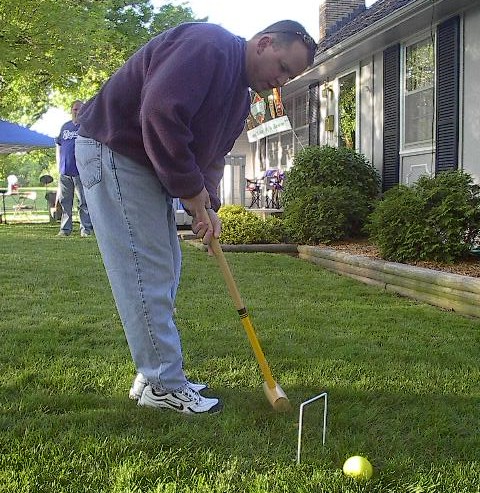
Future of the Yard Game
Here in Kansas City both of the main clubs have been focused on playing one-ball (cutthroat) croquet. Last fall Greg Clouse won the Missouri Croquet Association's (MCA) final tournament with an opening 16-wicket run. The run itself is not uncommon for the MCA, but it was a huge win for Clouse. Over the winter though, I thought about how that 16-wicket run really presents the main problem for the cutthroat game. Ultimately, the blue ball is facing the absolute possibility of no chance to win. Red is really in pretty rough shape as well if blue plays the proper defense. So I followed up with Clouse and laid out that concern.
"This is and has been a concern of ours," he said. "It is no fun (if you're not the one running the course) to watch someone run the course especially early in the game. In fact, others may be hurt by one person's, either mistake or non-experience."
He went on to say that the MCA had already decided to address the issue and was planning on playing some standard partners nine-wicket and singles (one player plays two balls) tournaments for the 2008 season.
This took the air out of me as I've always thought the one-ball game was a lot fun. You can accommodate six players on one field and the whole event takes on the feel of something like a bike race. Yeah some good fortune can be involved, but if you are on your game you'll always get your chance. Lately though, I've been getting a sinking feeling that as more players in my club develop the ability to go on that big run, ultimately it's a game of chance.
Bob Kroeger pretty much explained this for me on the phone a few years ago as we discussed some rules issues on the nine-wicket game, but I buried my head in the sand. Having the MCA change games brought it home for me.
At this point though, my club plays on backyard lawns, so that tends to throw some curve balls at the better players -- disrupting runs at extremely inopportune times. We can forge on, but I've started to work on a contingency plan -- just in case. I've scratched out a few rule changes to consider that would might help break up the potential for a 16-wicket run and preserve the one-ball game:
- Make the standard field 136' and extend the area between the stakes and respective wickets 24 feet. Putting the starting line at 20'. I thought this might mix things up at the beginning and possibly create some complications at the turning stake. Still, good players could handle that one.
- Put the starting line on the sideline (roughly perpendicular) to the current starting line (ala golf croquet). Again, this would mix things up a bit at the beginning as it would be impossible to score on that first shot.
- No bonus for the turning stake. I'm not sure the effect this would have, but it would be impossible to run the field in one turn. It might have the effect of creating two short games.
- Limit to only four players. Part of the problem is there are so many balls available. It takes a little more skill to string together a run with only four balls on the field. Also, taking a few of those balls off of the field reduces the "other player" mistakes that leads to the opponent win. I always view it as there is you, the guy with the ball and the four others. This means there are just two others. Still, part of the fun is emerging from a pack of six players.
The best solution really may be as I suggested above -- stay off of the smooth turf for cutthroat croquet. And perhaps for me it's time to let go of my obsessive attachment to the backyard game. It may be a signal to move on to singles and partner play on the nine-wicket course (plus golf croquet) and learn to appreciate the cutthroat game for what it is -- a great social contest for the backyard that provides a good base for croquet skills and strategy.
